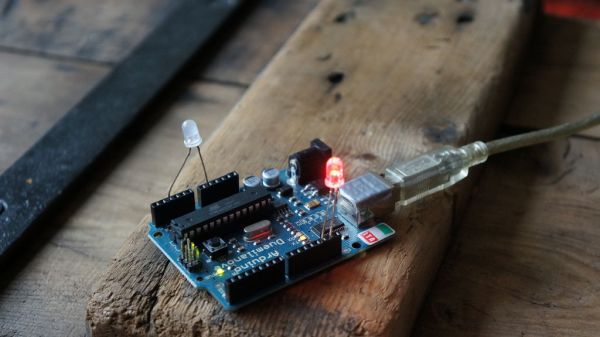As a result of the questions from lekirst on this ible of my hand: LED-as-lightsensor-on-the-arduino/ and the cleaner code made by hansc44 at: Arduino-Use-LED-as-a-light-sensor/ it was time to come with a better Ible. So here it is. (I didn’t solve lekirst’s problems yet so she probably is open for suggestions)
What is the idea?
You might know that a LED emits light when you put the right amount of volts on the right leads. The funny thing is that it also works the other way around. Not the leads, it doesn’t work when you put the leads the other way around. But what does work is that when you shine light on a LED it will GIVE current. It is a very small current but just enough for an Arduino to detect.
What will it do?
When you darken the sensor led, for instance by covering it with your hand, it will turn on the other LED.
Does this work with any LED?
As far as I know, it works with any LED, but not with any LED as good.
green and red LEDs seem to work best.
If trough experimenting you find out that other colors even work better, let me know.
Does it work with any light?
This sketch works very reliable with normal daylight. It is not fully tested in dark rooms or bright sunlight yet.
Step 1: You will need
You will need
- an Arduino board (Uno, Duemilanove or something like that)
- two LEDs
And really that’s it! (you could even do it with just one LED and use the SMD-LED on the Arduino board as the second LED)
You will need no tools.
You do need a computer with the Arduino software installed and a USB-cable to connect the Arduino board. (But if you have an Arduino board, you probably have that sorted already)
Step 2: Setting everything up

To set this project up, you just need to put the two LED’s in the Arduino.
- Put the LED that you want to use as the sensor with the long lead (this is the anode and positive lead) in pin analog 3 in the Arduino. This could also be an other analog pin, but then you need to change this in the sketch later on.
Put the other, short lead in the GND. - Put the other LED with the long lead in pin (digital) 13 in the Arduino. Put the short lead in the GND that is next to pin 13.
Now you just need to hook up the Arduino board with the computer and the fun can begin.
Step 3: Uploading the Sketch
int led = 13; // the pin where you will put the LED
int sensorpin = A3; // the analog pin where you put your sensorLED
int resetteller = 0; // the rest are counters and variables to calculate with
int sens = 0;
int teller = 0;
int basis = 1024;
int test = 1024;
int test2 = 1024;
int test3 = 1024;
// this are the values to play with to get better (or worse) results
int marge = 5; // the space between a positive and negative reading
int vertraging = 1; // the speed of the readings; a lower number is a higher speed
int samples = 70; // the amount of samples to compare to make one reading
int resetsamples = 30; // how many cycles to run the light on before you don’t trust the value anymore
void setup() {
pinMode(led, OUTPUT);
Serial.begin(9600); // no real part of the program, just for debugging
for(teller =0; teller < samples; teller++) {// remember the lowest value out of many readings
sens = analogRead(sensorpin);
if (sens < basis){basis = sens;}
delay(vertraging); // the sensor needs a delay here to catch its breath
}
}
Read more: Better LED as light sensor
